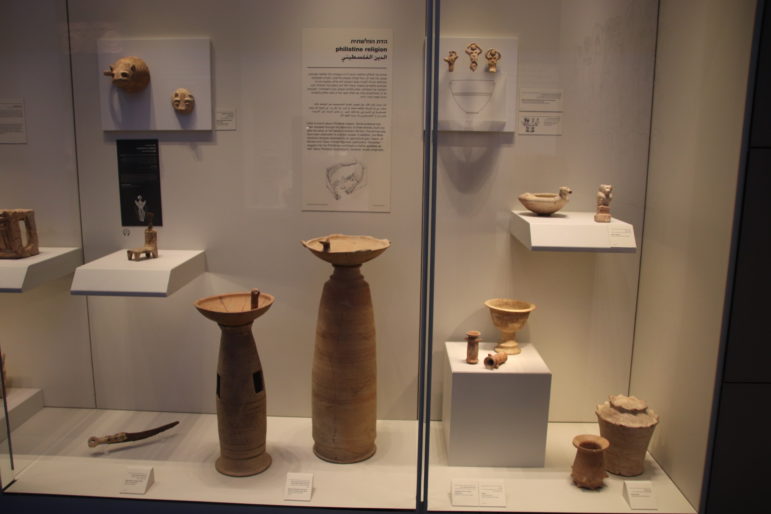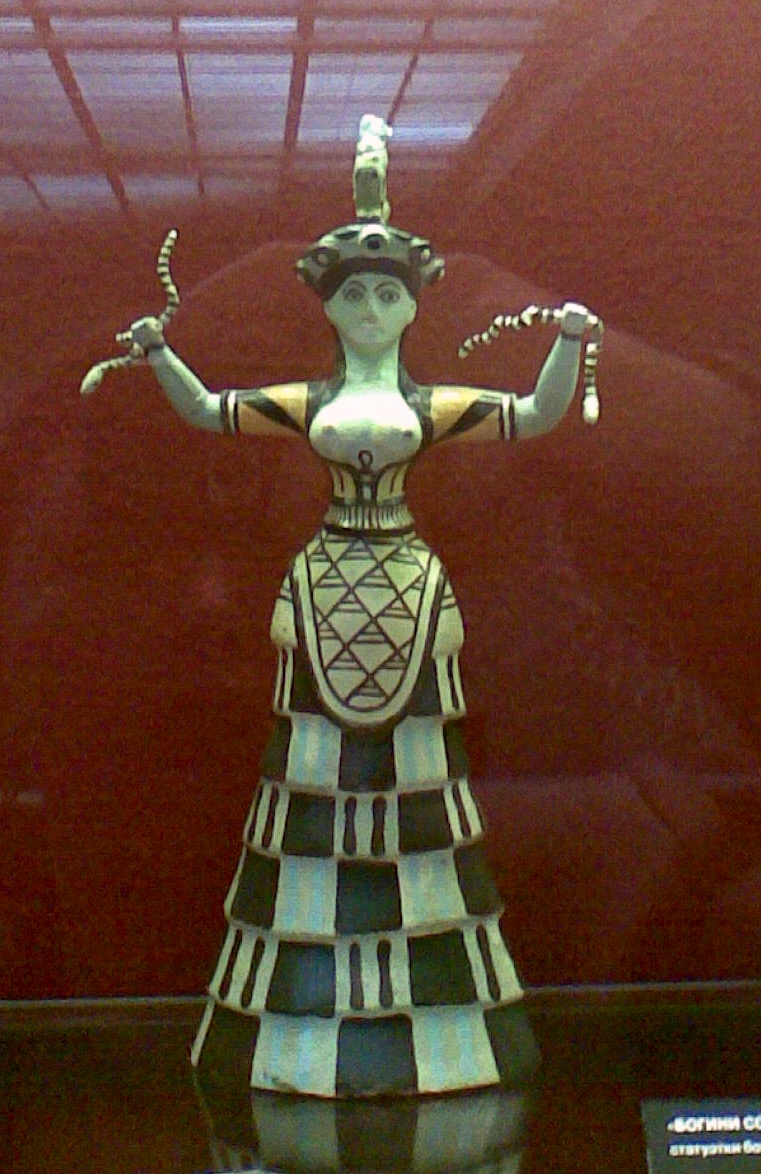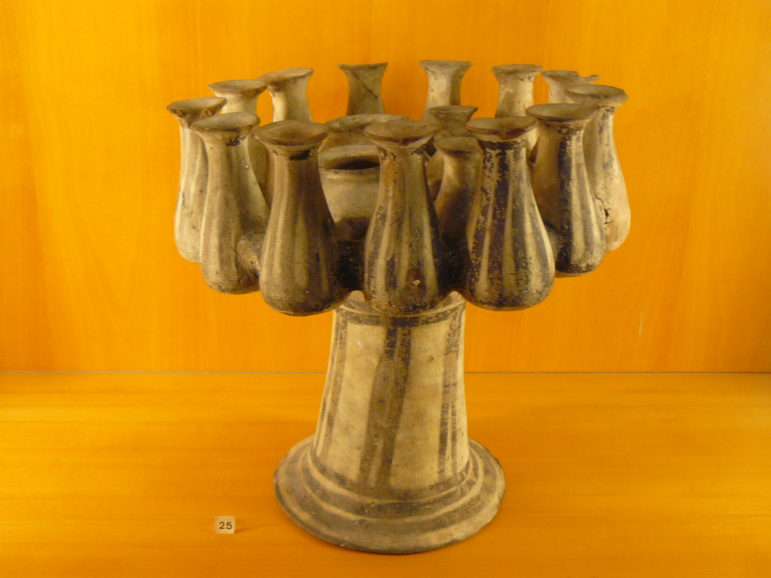TWH – The Philistines may be one of the most enigmatic people of the ancient Mediterranean as noted in Archaeology last month.
The Philistines are enigmatic for several reasons. First, they left minimal written records of their world. Second, the ancient Hebrews, their enemy, wrote most of what we know about them. Third, their appearance in history is linked to the Bronze Age Collapse which occurred around 1200 B.C.E.

Philistine artifacts, Israel Museum, Jerusalem, Israel – Image credit: Gary Todd from Xinzheng, China – CC0
The Bronze Age Collapse and the Sea Peoples
During the Bronze Age, several major powers in the Levant became linked by trade and exchange. Together, Egypt, the Hittites, and the Minoans-Myceneans became powerful culturally, economically, and militarily. Sometime in the 1200s B.C.E, a major crisis, developed in the Eastern Mediterranean.
Pollen and sediment analysis from Greece and the Levant show “severe aridity” from around 1250 B.C.E. This drought could easily have disrupted food supplies and trade. In turn, those disruptions could have led to social unrest and mass migrations throughout the region.
Egyptian records tell of a battle around 1175 B.C.E. In that battle, Ramses III fought the Sea Peoples. The current thought is that the Sea Peoples were refugees from that crisis. They began to raid the established powers in the region.
Evidence throughout the Eastern Mediterranean shows evidence of disruptions and violence. Some violence could be from internal unrest, rather than the Sea Peoples raiding. The date for this event is usually given as around 1200 B.C.E. Rather than a single event, it would have been more of a process over decades.
After 1200 B.C.E., the Minoan-Mycenean culture disappears. Greece enters the Greek Dark Ages. The Hittites of Anatolia disappeared. Egypt survived but lost control over Canaan. As Egypt lost control, the Hebrews, Philistines, and Phoenicians emerged.
A brief history of the Philistines
The Iron Age followed the Bronze Age. In the Levant, the Iron Age lasted from 1200 to 539 B.C.E. The Philistines lived in coastal parts of the southeastern Levant. They had five major cities, Ashdon, Askelon, Ekron, Gath, and Gaza. Only the still-inhabited Gaza remains unexcavated.

Map of the Philistine Pentapolis – Image credit: Cush – CC0
Historian Aren Maeir has challenged the historical consensus, which holds that the Sea Peoples conquered and settled in the Levant. They became the Philistines. He argues that the Sea Peoples consisted of a motley group of “opportunistic pirate tribes.” In the late 1200s and early 1100s B.C.E., some of them settled in the southern Levantine coast. Meir argues that they settled “mostly peaceably, among the local Canaanites.” Over time, they created the hybrid Philistine culture.
The last Philistine cities were destroyed by the neo-Babylonians in 604 B.C.E. The surviving Philistines were sent into exile in Mesopotamia. After a century or so, evidence of Philistinians disappears from history.
The Religion of the Philistines
The journal Religions published Philistine Cult and Religion: According to Archaeological Evidence. It surveyed studies of the known material remains of the Philistine religion. The article distinguished between their public cult and their household cults. Evidence showed local Canaanite cults largely influenced the public cults of the Philistines.
In contrast, the Aegean cultic practice largely influenced Philistine household cults. It also distinguished between the Levantine Iron Age I and the Levantine Iron Age II. The Levantine Iron Age I lasted from 1200 B.C.E. to 1000 B.C.E. The Levantine Iron Age II lasted from 1000 to 539 B.C.E.
The Philistine Public Cult
Ben-Shlomo defined public cult material as that found in temples or public shrines. Archaeologists identify temples based on “special ground plan, building techniques, separation of spaces, installations and type, quantity and location of specific finds.” Public cultic structures have an “inherent and rather constant cultic function.”
Excavations at Gath revealed Temple D3, dating to the Levantine Iron Age II. The Philistines had built Temple D3 on top of an earlier temple.
Temple D3 had an outer, north-facing courtyard, three rooms, and a broad room. In the back of that room, archaeologists found “a unique monolithic two-horned altar.” Found objects include 200 ankle bones, but very few figurines.
The temple in Tell Qasile dates from the Levantine Iron Age I. It had three strata. At its earliest level, excavators found a one-room shrine. Benches abutted the walls. It had a bamah or raised place for sacrifice.
In a later layer, builders enlarged the structure. It had an indirect entrance, an entrance room, and the main hall with pillars. In the back, another room in the back had an indirect entrance. Nearby, another one-room shrine stood. That one-room shrine contained many cultic vessels.
Other finds include “various anthropomorphic and zoomorphic libation vessels decorated in the Philistine Bichrome style.” None of the iconographies indicates Aegean influence. Archaeologists also found bowls in the shape of birds, as well as two terracotta pomegranate vessels.
The temple in Nahal Patish dates to late Levantine Iron Age I. It has an asymmetric L-shape. Someone would enter through a courtyard that contained pits for offerings, and an altar.
Two passages led out from the courtyard. The one on the right led to a square storeroom, an offering pit, and materials for cooking. The passage on the left led to an indirect entrance to the temple. That temple had a raised area for sacrifices. Steps led up to that raised area. Nearby, was a bronze knife, and gold foil pieces as well as other objects.
The objects and designs of temples show mostly Canaanite influence. Some cultic objects, however, show Philistine Bichrome style in their decorations.
Philistine household cults
Archaeologists identify household cult sites as those found in a domestic context such as “cultic corners” or “house shrines.” The author defined an area of a household as a “cultic corner” or a “house shrine” if almost all objects therein only had a symbolic use.
In their excavation of Ashkelon, archaeologists found a house shrine in Grid 38 room 572. They dated it to the 1100s B.C.E. In one room, they found what appears to be a four-horned altar made of earth, covered in lime plaster. That altar has similarities to a Cypriot “horns of consecration” object.
In Ashdod, Ashkelon, and Ekron, archaeologists found Aegean-style figures. They did not find many, but those they did had clear links to Aegean figurines. Archaeologists found those figurines in the Levantine Iron Age 1 households. Archaeologists found three major types: Psi figurines, the Ashdoda, and bovine figurines.
In Psi figurines, a schematic female holds her hands uplifted, in the form of the Greek letter psi (Ψ). They found these at Ashdod, Ashkelon, Ekron, and Tel Qasile.

Snake Goddess has possible origin of Philistine Ψ figurine – Pushkin Museum, Moscow – Image credit: shakko – CC BY 3.0
Some readers may note similarities between psi figurines and the Minoan Snake Goddess.
The “Ashdoda” depicts a sitting female. This terracotta has a small head with a crown-like hair dress, a long neck, and a schematic flat body. Her seat has four legs. The sculptor applied breasts, eyes, and a nose to that body.
Her features show both Aegean and Canaanite influence. It appears to have “evolved” from Mycenaean seated female figures. It only appears after the Bronze Age collapse.
At Ekron, archaeologists have found a decorated cow-like figurine. They have not found any other decorated animal-like figurines in the southern Levant in the early Iron Age. It had similarities to bovine figurines from the Aegean and Cyprus.

Kernos offering vessel – Image credit: Lyokoï – CC BY-SA 4.0
In Gath, archaeologists found a ceramic pomegranate and a zoomorphic vessel. They also found a “kernos,” a unique type of terracotta structure for making offerings. It takes the form of a “tubular ring with various head spouts and vessels attached to it.”
No one has yet found a Philistine equivalent of the Eddas, the Homeric epics, or the Ulster Cycle. Without some texts like those, moderns can never know the names of their gods, let alone their myths.
The Wild Hunt is not responsible for links to external content.
To join a conversation on this post:
Visit our The Wild Hunt subreddit! Point your favorite browser to https://www.reddit.com/r/The_Wild_Hunt_News/, then click “JOIN”. Make sure to click the bell, too, to be notified of new articles posted to our subreddit.